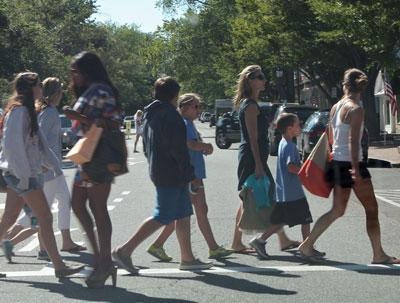GUESTWORDS: Coyote Hampton: A Proposal
GUESTWORDS: Coyote Hampton: A Proposal
A heartfelt thanks to East Hampton citizens for supporting our efforts to import coyotes from Maine to the Hamptons. You are right that coyotes will go a long way to cleaning up the present summertime mess that one resident described in a letter to The Star as a climate of “hell.”
I have lived in the Hamptons for 40 years and watched our town degenerate from paradise to a sweating, ill-mannered, noisy, deer-and-tick-infested traffic jam. Something must be done — but what?
Our answer: coyotes.
Let me regress a bit — for years I have followed the controversy over deer (and ticks). Some want shooting, some contraceptives (for the deer), others just surround their houses with 10-foot-high deer fence so that the deer stand on the outside looking in as if we humans are in a zoo and the deer are nonpaying customers. I do not appreciate being caged in a zoo for the amusement of deer. I am a consumer with a genuine lifestyle — not an object of amusement.
So what has this to do with coyotes? Just this: Because the Hamptons have evolved into such a “hell,” years ago I fled north to Maine for the summer — a peninsula jutting into the sea, a hilltop cabin surrounded by blueberry fields, a view of Acadia National Park’s mountains, sun and moon rising from the water, in fact, an immense leafblowerless, almost scary, and certainly holy silence. That’s summer in my area of Maine.
Our Maine tourists are mannerly, traffic is modest, and there are few ticks. Why few ticks? Because the deer are controlled by the coyotes. To be a baby deer in Maine is to be eaten — much as we consumers hack up lamb and veal to display in neat packages at the meat counter without further thought. In fact, just to be really far, far out — much as we ate TV dinners while watching George W.’s “shock and awe” campaign, which destroyed, oh, say, 300,000 Iraqi children, give or take a thousand. Coyotes do it better but they aren’t prime-time material.
There are of course downsides to this miracle cure to the Hamptons hell: Coyotes also attack cats and dogs and have been known to bring down a jogger or two. My neighbor, Jon Swift, almost lost his 85-pound mutt Jack this summer when Jack was surrounded in the twilight by a pack of coyotes.
Here’s how coyotes do it (clever fellows). They invited Jack — a kin canine — to play with them. “Yip, yip, yip!” dancing about. Jack, a boisterous king of the fields, was interested. Who doesn’t like to play with cousins? But soon Jack noticed that these cousins played rough. In fact, Jack was dinner. My neighbor stopped all this by banging pots and pans and the coyotes retreated.
After that I kept my dogs in after sunset. In the cabin, they listened to the coyotes in the fields with some worry. The coyotes cackled and yapped like a New England town meeting, especially after they had killed something yummy.
The point? After we introduce coyotes to the Hamptons to clean up our deer, we must be vigilant with our cats and dogs (cats are a mere appetizer for coyotes).
Heartless, you say? I love deer. Often while driving I will pull over to the roadside while they graze and within a few feet of them gaze into their eyes. Such innocence. And when they leap no animal, including us — certainly us! — comes close to their grace. Sigh.
But we must remember we are being destroyed by grace. As consumers we must be practical. We got rid of grace 2,000 years ago, washed our hands of him (although he did have some practical uses). So we can’t let it return in some burst of ill-advised sentimentality.
Why? So we can get our gardens and shrubs back from the deer and end the plague of tick infestations nurtured by our innocent but deadly cloven-hoofed predators. I’ve had Lyme disease twice and two of my dogs did too, as did my wife. That stuff can kill you. It’s grace or us.
My Maine neighbor offered a further bit of wisdom for coyote export to the Hamptons. Since coyotes like to gang up and attack whatever looks like lunch — i.e., joggers in shorts — all it will take is for one jogger or skateboarder or roller skater to be terrified by a pack of coyotes and for word to get back to Manhattan, and our tourist industry, guided by our esteemed town board (“the business of America is business”), will collapse. Our sidewalks will be walkable again; the summertime hoo-ha will flee to Nantucket, where it belongs. Ralph Lauren and Tiffany’s and the rest will abandon Main Street. We will have our village back again.
Think of it. Mom-and-pop stores. Maybe the Pets Painted With Love shop will return. No more real estate offices inflating prices into the many millions for the 1 percent who’ve made the summertime Hamptons the world epicenter for excess.
Whoops, I just tipped my hand. I hadn’t meant to preach. This is a practical proposal. I didn’t mean to note that one $5,000 sweater purchased in East Hampton Village would save the lives of hundreds of suffering children in poor countries. But I’m getting out of control here. Rage is seeping in. I’m mad, you see, losing it.
Best turn it all over to the coyotes. After they have done their job, we will have our town back.
Then we can slaughter the coyotes.
Bill Henderson is founder of Pushcart Press and editor of the annual Pushcart Prize. His latest book is “All My Dogs: A Life.”


